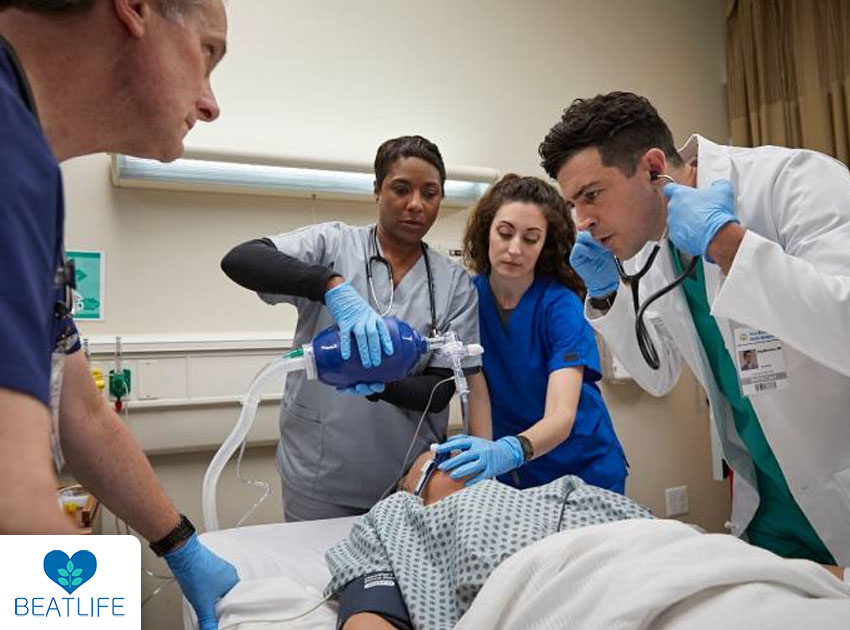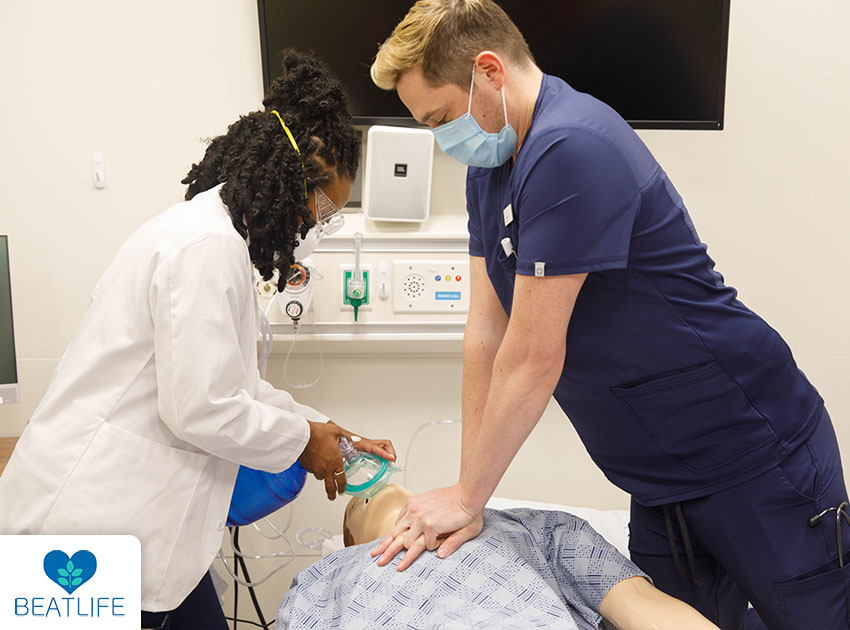” Is BLS the same as CPR ? ” is a frequently asked question in the field of life-saving techniques because the terms Basic Life Support (BLS) and Cardiopulmonary Resuscitation (CPR) are frequently used interchangeably. Even though they are both essential in emergency medical situations, a closer look shows that they are different parts of the larger emergency response spectrum. The purpose of this article is to clarify the differences between BLS and CPR by examining their distinct roles, methods, and important distinctions. It is crucial for the general public as well as healthcare professionals to comprehend these distinctions in order to enable people to act appropriately in urgent situations and possibly save lives.
In order to better understand whether Is BLS the same as CPR? or whether their differences can lead to more successful life-saving measures, let’s take a closer look at the field of emergency medical care as well as getting to know the CPRmeter device produced by BEATLIFE company.
Contents
Understanding the Basics
The terms Cardiopulmonary Resuscitation (CPR) and Basic Life Support (BLS) are often used interchangeably in the context of emergency medical care, raising the question: Is BLS the same as CPR? It’s critical to understand the varied roles each plays in interventions aimed at saving lives in order to answer this question. Basic Life Support (BLS) is an all-inclusive emergency medical protocol that includes a range of procedures designed to stabilize people in life-threatening circumstances. Healthcare workers frequently work toward earning their BLS certification, which equips them with the knowledge and abilities needed to respond deftly in emergency situations. This all-inclusive method comprises evaluating the patient’s status, opening the airway, providing rescue breathing, carrying out chest compressions, and using Automated External Defibrillators (AEDs) and CPRmeter as needed.
However, Cardiopulmonary Resuscitation (CPR) becomes a distinct technique within the larger framework of Basic Life Support (BLS). The goal of CPR is to keep the heart from stopping and preserve oxygen and blood flow, mostly by applying chest compressions and breathing rescue gases. While BLS is frequently administered by medical professionals, anyone can learn CPR, which equips bystanders with vital skills in an emergency. When someone stops breathing or experiences sudden cardiac arrest, CPR is an essential intervention that keeps them alive until emergency medical assistance can be provided.
When contemplating the question “Is BLS the same as CPR,”, it’s important to understand that although BLS includes CPR, there are differences between the two in terms of certification and training requirements. While CPR training is intended for a wider audience and equips laypeople with the skills necessary to respond appropriately in emergency situations, BLS certification is sought by healthcare professionals to perform a variety of emergency procedures. This knowledge guarantees that people, whether they are bystanders or medical professionals, are prepared to handle emergency situations and make a difference in those crucial moments when quick thinking and action are crucial.

Distinguishing BLS from CPR
One common misconception that often surfaces in discussions surrounding emergency medical procedures is whether Basic Life Support (BLS) and Cardiopulmonary Resuscitation (CPR) are essentially the same. While the terms are used interchangeably in casual conversation, it’s crucial to recognize the nuanced differences between BLS and CPR.
1. Comprehensive Emergency Care vs. Specific Life-Saving Technique:
BLS: BLS, as the broader concept, involves a comprehensive set of emergency medical procedures. It encompasses the initial assessment of a patient’s condition, clearing the airway, providing rescue breathing, administering chest compressions, and utilizing Automated External Defibrillators (AEDs) when needed. BLS is the foundation for emergency care, extending beyond the specific techniques of CPR.
CPR: CPR, on the other hand, refers specifically to the life-saving technique of chest compressions and rescue breaths. It is a vital component of BLS but represents a focused subset. CPR aims to maintain blood circulation and oxygenation in the absence of a heartbeat or when someone stops breathing.
2. Professional Certification vs. Layperson Training:
BLS: Typically, BLS certification is sought by healthcare professionals—doctors, nurses, paramedics, and other medical personnel. The training involves a comprehensive understanding of emergency medical procedures and is essential for those responsible for immediate patient care in medical settings.
CPR: CPR training, while also certifiable, is more widely accessible to the general public. Courses are designed to teach laypersons the specific techniques of chest compressions and rescue breaths. Many workplaces, community organizations, and educational institutions offer CPR certification programs, empowering individuals to respond effectively in emergencies.
3. Role in Emergency Response:
BLS: BLS plays a foundational role in the initial response to emergencies, offering a holistic approach to stabilizing a patient’s condition. Healthcare professionals with BLS training are equipped to manage a range of critical situations until advanced medical care is available.
CPR: CPR comes into play during specific emergencies, such as sudden cardiac arrest or situations where someone stops breathing. Bystanders trained in CPR can initiate this life-saving technique promptly, significantly increasing the chances of survival until professional help arrives.
4. Introducing CPRmeter for Enhanced Precision:
In the realm of CPR, precision is paramount. The use of innovative tools, such as the CPRmeter, can enhance the accuracy of chest compressions. CPRmeter is a device designed to provide real-time feedback on the depth, rate, and quality of chest compressions, ensuring that each compression is effective. Incorporating CPRmeter into training and emergency response practices can further optimize the outcomes of CPR efforts.
5. The Importance of Clarity in Communication:
It’s vital to communicate with precision, especially in emergency situations. While BLS and CPR are intertwined, recognizing their distinctions ensures that individuals understand the scope of their training and the level of emergency care they can provide.

Can BLS be performed by non-medical professionals in emergency situations?
Yes, Basic Life Support is designed to be accessible and performed by non-medical professionals in emergency situations. BLS training equips individuals with fundamental life-saving skills, including CPR , AEDs, and assistance in various medical emergencies. This training is crucial for bystanders, caregivers, and individuals in diverse settings, empowering them to respond effectively to cardiac arrests, choking incidents, and other emergencies. The simplicity and effectiveness of BLS techniques make them accessible to anyone, emphasizing the importance of immediate intervention to improve the chances of survival and positive outcomes in critical situations.
Is BLS suitable for children and infants, or is it designed only for adults?
BLS training is comprehensive and includes techniques suitable for individuals of all age groups, including children and infants. The training emphasizes the importance of adapting life-saving approaches based on the age and size of the individual requiring assistance. BLS covers specific protocols for providing CPR to children and infants, considering their unique physiological characteristics. The goal is to equip individuals with the knowledge and skills necessary to respond effectively to medical emergencies in pediatric cases, recognizing the differences in approach compared to adult scenarios. Therefore, BLS is not exclusively designed for adults but extends its applicability to encompass the diverse needs of the entire population, ensuring a well-rounded and inclusive life-saving approach.
Conclusion
In conclusion, understanding that BLS and CPR are not synonymous is key to appreciating the comprehensive nature of emergency medical care. BLS serves as the umbrella term encompassing various life-saving procedures, with CPR being a crucial and specific technique within this broader framework. Both are indispensable in different contexts, emphasizing the importance of tailored training, clear communication, and, when applicable, the use of advanced tools like CPRmeter in emergency response scenarios.
Reviewed by Dr Jamshidi Mohammad Reza

